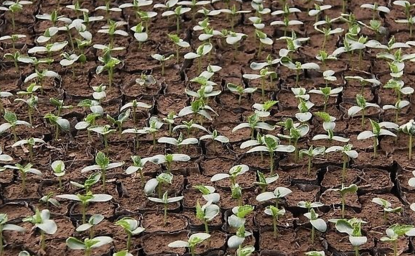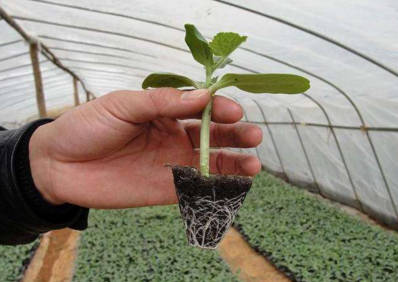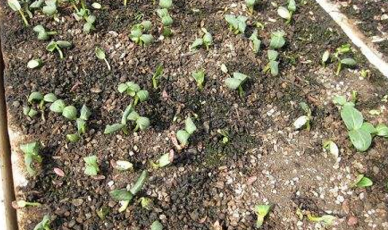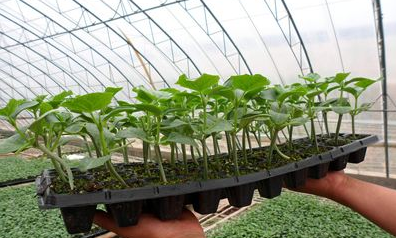Several common physiological diseases during cucumber seedlings
Physiological diseases are non-infectious, also known as non-infectious diseases. Too much or too little nutrients and water, too high or too low temperature, too strong or too weak sunlight, and environmental factors such as poor soil ventilation or toxic gases in the air; or the quality of the seeds themselves; or seed inheritance Gene mutations cause the seedlings to behave abnormally. Although these diseases are not contagious, they often occur in the same condition, and can induce and aggravate the occurrence and damage of infectious diseases, causing certain losses.
1 "burning root"
1.1 Identification and harm
The damage is light or the disease begins, the roots are apex yellow-brown water-soaked, and the roots and roots of the young stems are soaked in yellow-brown to chestnut brown rot. The diseased seedlings are easy to pull up, and the cotyledons are slightly smaller and thicker than the normal seedlings, dark green, sometimes yellowish brown dry necrosis at the edge or apex of the cotyledons, slow growth or death after the damage. In the diseased seedbed, it is common to occur in general or spotting, and it is often necessary to replay.
1.2 Causes
"burning roots" is also known as fat. The unfertilized organic fertilizer is used in the nutrient soil, and the organic fertilizer continues to ferment and damage the root; or the fertilizer is not uniformly applied, or the application is excessive, so that the concentration of the fertilizer solution in the soil is always kept high, and the negative osmotic pressure is generated, resulting in the root system being abnormal. Caused by absorbing water from the soil.
1.3 Prevention methods
1 Use nutrient soil with fully decomposed organic fertilizer; mix well with fertilizer and mix well.
2 When the fertilizer occurs, timely sprinkle water to reduce the concentration of the fertilizer solution and minimize the damage.

2 roots
2.1 Identification and harm
It is a common disease during cucumber seedlings in low temperature seasons. The diseased seedlings are easy to pull up, no white roots, and the root rust is brown and watery until it rots. The upper part of the ground is wilting, and the leaf color turns yellowish green or milky yellow, and it begins to burn off from the edge of the leaf. The growth of the diseased seedlings is extremely slow. In severe cases, the tablets are wilted and die, causing local destruction.
2.2 Causes
Caused by long-term low temperature and high humidity, that is, the soil temperature lasts for less than 12 ° C for a long time, and when there is excessive watering or rainy weather, the roots are in a low temperature, too wet and anoxic state, and their metabolism and absorption capacity are reduced. Can not grow normally, leading to browning of root necrosis.
2.3 Prevention methods
1 bed soil is loose and fertile, and the bed surface is flat, so that the roots grow and the water is evenly distributed when sprinkling water.
2 Strengthen the temperature and humidity management of the seedbed, properly conduct ventilation, light transmission, exercise the seedlings, and avoid the soil temperature of the seedbed is too low and too wet.
3 The electric hotline is used for seedling raising, and the bed soil temperature is controlled at about 16 °C, generally not lower than 12 °C.
4 Pour the bottom water before sowing, properly control the water during the whole seedling process, and sprinkle water when necessary; prepare dry fine soil, when the bed soil humidity is high, it can be sprinkled on the bed surface to reduce humidity.

3 long
3.1 Identification and harm
The stems of the seedlings are thin and long, the spacing between the nodes is large, the leaves are light, the leaves are thin, the tissues are soft and the roots are weak. Its resistance to stress is poor, it is easy to be frozen, prone to sunburn and stagnation, etc.; due to malnutrition, the flower bud differentiation period is delayed, the number of flower buds is small, and it is easy to fall, resulting in poor early maturity and low yield.
3.2 Causes
The main reason is caused by insufficient light, high temperature and excessive humidity. The temperature difference between day and night is small, the seeding is too dense, the ventilation is poor, and the excessive nitrogen fertilizer can also cause the seedlings to grow. The hypocotyls of newly emerged seedlings are sensitive to temperature and are not well managed, often resulting in length.
3.3 Prevention methods
1 Rationally prepare nutrient soil to avoid the addition of quick-acting nitrogen fertilizer such as urea, even if it is used properly.
2 Use a plastic film with good light transmission to strengthen the temperature and humidity management of the seedbed, and timely and properly ventilate and transmit light.
3 After the seedlings are unearthed, the bed temperature is controlled to be 15-20 °C in the first half of the night, 10-15 °C in the middle of the night, and no less than 5 °C in the morning, maintaining a certain temperature difference between day and night to prevent the hypocotyl growth of the seedlings from growing too fast.
4 sowing is not dense, not to prevent the mutual crowding of the seedlings caused by the length.

4 low temperature barrier and freezing damage
Low temperature barriers and freezing damage are frequent production problems during winter and spring cucumber seedlings. Improper management or long-term rain and snow, low temperature weather is prone to occur, in severe cases often need to replay, significantly affecting production.
4.1 Identify and harm
The victim is light or light, and the apex, margin or part of the cotyledons of the cotyledons are chlorotic, yellow to white. When heavy, it may cause some cotyledons or some true leaves to wither and even die. When the freezing damage occurs, the edge of the cotyledon (especially the back of the leaf is obvious) or the water leaves appear on the true leaves, and even the seedlings are soaked and swelled, and finally die dry. Prolonged low temperature for a long time often results in no new roots, slow growth, can lead to weak parasite infestation, and even die.
4.2 Causes
Cucumber has weak cold tolerance, and it will suffer from 0 to 10 °C. It is less than 3 to 5 °C. When the temperature drops below the low temperature limit that cucumber seedlings can tolerate, depending on the degree of low temperature and the length of time, the degree of physiological disturbance is different, and thus various symptoms are exhibited.
4.3 Prevention methods
1 Strengthen seedbed management and insulation measures, promote electric hotline seedlings, timely ventilation and light, and beware of cold wind intrusion.
2 Pay close attention to the weather forecast during the nursery period, especially prepare for the sudden cold current, and prepare the cover to prevent damage.
3 Do a good job before replanting seedlings to improve the adaptability and stress resistance of seedlings.
4 After freezing, pay special attention to make the temperature of the seedbed rise slowly. After sunrise, use the straw curtain to properly shade, so that the physiological function of the cucumber can be slowly recovered. Do not rush to see the sun and minimize the loss.

5 out of stock
5.1 Identification
After sowing, some seeds do not emerge for a long time, resulting in the lack of seedbeds; or the emergence of long seedlings, resulting in different sizes of melon seedlings are called seedlings.
5.2 reasons
Seeds are sown without germination, and the application of unfertilized organic fertilizer or chemical fertilizer is excessive. After sowing, long-term rain and snow, low temperature will cause the bed temperature to be low, and the bed soil moisture is too high (causing rotten species) or too low (impact pair The absorption of water, etc., as well as the quality of the seeds themselves (such as the seeds of the seeds, the low maturity of the seeds and the seeds of the seeds) can cause seedlings.
5.3 Prevention methods
For different causes, take corresponding measures to prevent (some measures can be found in the relevant section above).
6 yellow (white) seedlings
6.1 Identification and harm
It occurs only occasionally in seedlings and has no effect on production. After being unearthed, the diseased seedlings remained yellow (white) color. Because photosynthesis was severely blocked or photosynthesis could not be carried out at all, the seedlings grew slowly and eventually died.
6.2 Causes
Mainly due to genetic variation, the seedlings are unable to perform normal physiological activities.
6.3 Prevention methods
It is not necessary to carry out targeted prevention and control, and it is only necessary to remove the diseased seedlings during the management of the seedbed.
Guangzhou Zhongzhinan Supply Chain Co.,Ltd. , https://www.gzzhongzhinan.com